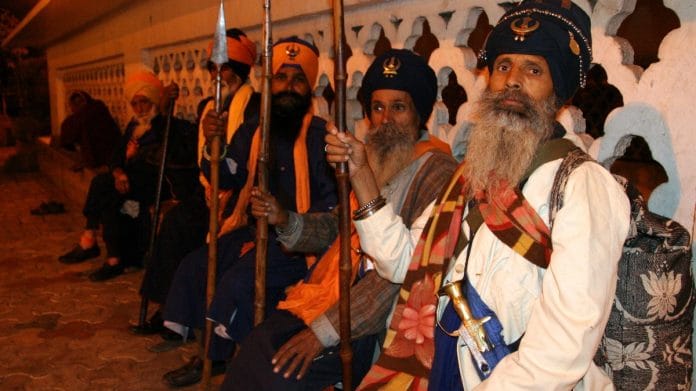Thank you dear subscribers, we are overwhelmed with your response.
Your Turn is a unique section from ThePrint featuring points of view from its subscribers. If you are a subscriber, have a point of view, please send it to us. If not, do subscribe here: https://englishdev.theprint.in/subscribe/
A group of three Nihangs brutally attacked Shiv Sainik Leader, Sandeep Thapar, on 5 July with swords in full public view at Ludhiana, leaving him grievously injured. Two of the three accused have been arrested. Taking immediate cognisance, the Punjab Governor, Shri Banwarilal Purohit, who has decided to ‘personally monitor’ the case, met the Ludhiana police commissioner, Shri Kuldeep Singh Chahal as well as the Deputy Commissioner the following day, demanding a ‘thorough investigation’, arrest of the third accused ‘as soon as possible’, and ‘strict punishment’ of the guilty. Suspicion is also being raised against Sandeep Thapar’s gunman, ASI Sukhwant Singh, for dereliction of duty when he failed to confront the sword-wielding Nihangs, despite being better armed—another aspect that the Governor wants probed, followed by ‘strict action’ against the gunman, if found guilty.
Based on preliminary interrogation of the two accused, prima facie the attackers were ‘upset with Thapar’s provocative videos and speeches against Sikh hardliners’
During his discussions, the Governor also expressed his concern about similar incidents in the recent past, and rightly since there have been so many. Many analysts attribute the Governor’s intervention to the fact that in most such incidents, the police have failed to deliver justice, possibly, from fear of raising Nihang dander. Beginning 2015, there have been fifteen killings in Punjab. In all, without exception, the police have carried out a sham investigation and seldom brought the culprits to book.
On 16 January 2024, a Nihang killed an unarmed 35-year-old man in cold blood within the premises of a Gurdwara in Phagwara after the latter had confessed his intention to commit sacrilege. Later that month, on 28 January, an armed mob of over 100 Sikhs, mostly Nihangs, brutally attacked the president of a gurdwara management committee, a 70-year-old Sikh army veteran, within the gurdwara premises in District Tarn Taran over the tentative removal of a picture of Jarnail Singh Bhindrawale. In another ugly incident, Padam Shri Kartar Singh, a highly respected senior citizen honoured with the Arjuna Award for his excellence in international wrestling was viciously attacked by an armed mob of over 30 persons on 31 March in District Taran Taran.
On 4 May, a Sikh youth all of nineteen years, undergoing psychiatric treatment for mental instability, tore off some pages from the Guru Granth Sahib in the Gurdwara of village Bandala (District Ferozepur). Shortly thereafter, he was brutally assaulted by a mob of mostly Nihangs and killed, in the presence of police personnel, even as the boy’s father pleaded for mercy, offering the boy’s medical documents as proof of medical treatment. Strangely, the Akal Takth, the highest seat of Sikh spiritual and temporal authority, issued a statement supporting the murder and ‘taking the law in their own hands’ in the pursuit of justice.
While disrespect of any religion is condemnable and all sacrilege, hate-speech, deliberate or otherwise, is punishable under the Indian Penal Code (now BNS), no civilised society could ever condone the murder of a human being on claims of disrespecting a religious symbol, book, picture, or human being.
Does such ghastly sacrilege- or hate speech-related violence find place in the larger Sikh religious context?
Moderate Sikh voices frown upon the emotive backlash against the frenzied hullabaloo rising at the drop of a hat over alleged incidents of ‘bedabi’ (sacrilege)—at least 400 since 2013 according to the Shiromani Gurdwara Parbandhak Committee (SGPC), the apex Sikh body—or hate speech.
They lament: “Sikh ethos has long espoused a formless creator while condemning ‘murti puja’ (idol worship). However, in fallacy, once the Guru is wholly equated and identified with a physical form, the danger to take quick and grave offence at anything and everything done to this Form, by accident or design, is severely palpable around us.”
Even the scriptures nowhere justify such ossification of spirituality, they argue:
Gur kā bacẖan basai jī▫a nāle.
Jal nahī dūbai ṯaskar nahī levai bẖāhi na sākai jāle. ||1||
The Guru’s Word abides with my soul.
It does not sink in water; thieves cannot steal it, and fire cannot burn it. II 1 II
- Guru Arjan Dev, SGGS, 679.
Many Sikhs and non-Sikhs alike are equally appalled at the hair-trigger tendency for mindless violence, especially among Nihangs. In founding the sant-sipahi, the Tenth Guru particularly condemned violence against the unarmed, sadly, a growing phenomenon in Punjab of today:
Mazan teg khoon kas be dareg l Tura neej khoo charakh rezad bateg l 69 l
Do not strike the helpless, else the Lord will strike you – Stanza 69, Zafarnamah
Nonetheless, what concerns the common man most in Punjab is the erosion of effective policing, especially in matters of alleged ‘sacrilege’ or ‘hate speech’ against the Sikh religion and hardliners.
Will the Governor be able to ensure justice this time?
These pieces are being published as they have been received – they have not been edited/fact-checked by ThePrint.


